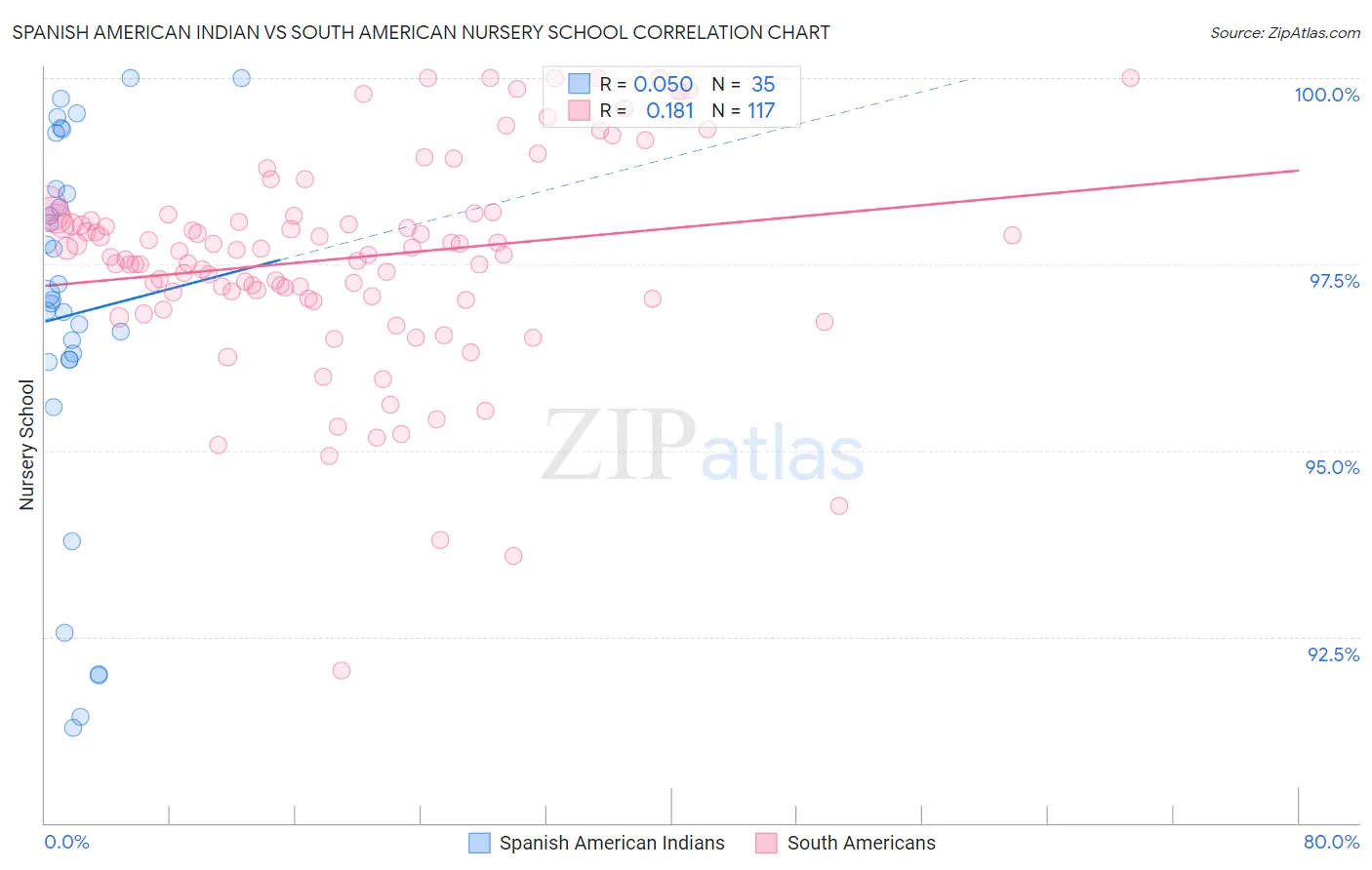Spanish American Indian vs South American Nursery School
COMPARE
Spanish American Indian
South American
Nursery School
Nursery School Comparison
Spanish American Indians
South Americans
95.8%
NURSERY SCHOOL
0.0/ 100
METRIC RATING
347th/ 347
METRIC RANK
97.6%
NURSERY SCHOOL
1.0/ 100
METRIC RATING
244th/ 347
METRIC RANK
Spanish American Indian vs South American Nursery School Correlation Chart
The statistical analysis conducted on geographies consisting of 73,150,359 people shows no correlation between the proportion of Spanish American Indians and percentage of population with at least nursery school education in the United States with a correlation coefficient (R) of 0.050 and weighted average of 95.8%. Similarly, the statistical analysis conducted on geographies consisting of 494,178,447 people shows a poor positive correlation between the proportion of South Americans and percentage of population with at least nursery school education in the United States with a correlation coefficient (R) of 0.181 and weighted average of 97.6%, a difference of 1.9%.

Nursery School Correlation Summary
| Measurement | Spanish American Indian | South American |
| Minimum | 91.3% | 92.1% |
| Maximum | 100.0% | 100.0% |
| Range | 8.7% | 7.9% |
| Mean | 96.8% | 97.6% |
| Median | 97.0% | 97.7% |
| Interquartile 25% (IQ1) | 96.2% | 97.1% |
| Interquartile 75% (IQ3) | 98.5% | 98.2% |
| Interquartile Range (IQR) | 2.3% | 1.1% |
| Standard Deviation (Sample) | 2.5% | 1.4% |
| Standard Deviation (Population) | 2.5% | 1.4% |
Similar Demographics by Nursery School
Demographics Similar to Spanish American Indians by Nursery School
In terms of nursery school, the demographic groups most similar to Spanish American Indians are Immigrants from Yemen (95.9%, a difference of 0.050%), Nepalese (96.2%, a difference of 0.39%), Immigrants from El Salvador (96.2%, a difference of 0.40%), Salvadoran (96.4%, a difference of 0.55%), and Immigrants from Mexico (96.4%, a difference of 0.58%).
| Demographics | Rating | Rank | Nursery School |
| Central Americans | 0.0 /100 | #333 | Tragic 96.6% |
| Immigrants | Dominican Republic | 0.0 /100 | #334 | Tragic 96.6% |
| Bangladeshis | 0.0 /100 | #335 | Tragic 96.6% |
| Guatemalans | 0.0 /100 | #336 | Tragic 96.6% |
| Immigrants | Cambodia | 0.0 /100 | #337 | Tragic 96.5% |
| Immigrants | Fiji | 0.0 /100 | #338 | Tragic 96.5% |
| Immigrants | Guatemala | 0.0 /100 | #339 | Tragic 96.4% |
| Immigrants | Central America | 0.0 /100 | #340 | Tragic 96.4% |
| Immigrants | Cabo Verde | 0.0 /100 | #341 | Tragic 96.4% |
| Immigrants | Mexico | 0.0 /100 | #342 | Tragic 96.4% |
| Salvadorans | 0.0 /100 | #343 | Tragic 96.4% |
| Immigrants | El Salvador | 0.0 /100 | #344 | Tragic 96.2% |
| Nepalese | 0.0 /100 | #345 | Tragic 96.2% |
| Immigrants | Yemen | 0.0 /100 | #346 | Tragic 95.9% |
| Spanish American Indians | 0.0 /100 | #347 | Tragic 95.8% |
Demographics Similar to South Americans by Nursery School
In terms of nursery school, the demographic groups most similar to South Americans are Asian (97.6%, a difference of 0.0%), Bolivian (97.6%, a difference of 0.0%), Peruvian (97.6%, a difference of 0.0%), Immigrants from Indonesia (97.7%, a difference of 0.010%), and Liberian (97.7%, a difference of 0.010%).
| Demographics | Rating | Rank | Nursery School |
| Immigrants | Western Asia | 1.9 /100 | #237 | Tragic 97.7% |
| Nigerians | 1.7 /100 | #238 | Tragic 97.7% |
| Immigrants | Eastern Asia | 1.6 /100 | #239 | Tragic 97.7% |
| Koreans | 1.4 /100 | #240 | Tragic 97.7% |
| Immigrants | Indonesia | 1.1 /100 | #241 | Tragic 97.7% |
| Liberians | 1.1 /100 | #242 | Tragic 97.7% |
| Asians | 1.1 /100 | #243 | Tragic 97.6% |
| South Americans | 1.0 /100 | #244 | Tragic 97.6% |
| Bolivians | 1.0 /100 | #245 | Tragic 97.6% |
| Peruvians | 1.0 /100 | #246 | Tragic 97.6% |
| Immigrants | Middle Africa | 0.9 /100 | #247 | Tragic 97.6% |
| Indians (Asian) | 0.9 /100 | #248 | Tragic 97.6% |
| Immigrants | Eastern Africa | 0.9 /100 | #249 | Tragic 97.6% |
| Immigrants | Senegal | 0.9 /100 | #250 | Tragic 97.6% |
| Ethiopians | 0.8 /100 | #251 | Tragic 97.6% |